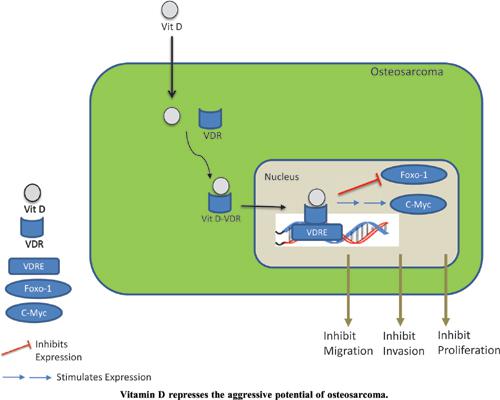Endocrine, Metabolic & Immune Disorders - Drug Targets ( IF 2.0 ) Pub Date : 2021-06-30 , DOI: 10.2174/1871530320666200821155756 Behnoosh Tahbazlahafi 1 , Malihe Paknejad 1 , Shahnaz Khaghani 1 , Sahar Sadegh-Nejadi 1 , Ehsan Khalili 1

|
Background: Osteosarcoma (OS) is the basic bone neoplasm with lower survival and poor prognosis. It is distinguished by its offensive nature and metastatic potential. The fundamental death source in OS patients is lung metastasis. In addition, the proliferation and cell migration are thus essential for cancer progression, especially for intrusion and transformation. Several studies have illustrated that 1,25-Dihydroxyvitamin D (1,25(OH)2D) has a critical role in the growth and differentiation of bone. However, knowledge of the outcome of 1,25(OH)2D on the progression and incursion of osteosarcoma cells is minimal.
Objective: The present study aimed to analyze the effect of different concentrations of 1,25(OH)2D on the multiplication, progression, and intrusion of OS cells and verify the effective doses of 1,25(OH)2D that can decrease the intensity of the disease and improving the prognosis in OS patients.
Methods: Saos-2 cells were treated with 1,25(OH)2D (0, 50, 100, and 200 nM) for 48, 72, and 96 hours. Proliferation, invasion, and migration were determined by MTT assay, Transwell assay, and Scratch test, respectively. The levels of c-Myc and FOXO1 proteins were determined by Western blotting.
Results: The proliferation, invasiveness, and migration of Saos-2 cells that were treated with 1,25(OH)2D were significantly decreased compared with untreated cells. Although 1,25(OH)2D notably decreased c-Myc protein levels (after 48 and 72 hours), FOXO1 protein levels have been significantly increased after 48 and 72 hours. 1,25(OH)2D and the vitamin D receptor (VDR) suppress c-Myc function through regulating the c-Myc/MXD1 network and thus, providing a molecular basis of 1,25(OH)2D related to the cancer-preventive actions.
Conclusion: Based on the present results, 1,25(OH)2D by targeting c-Myc and FOXO1 expression displays anti-invasive, anti-migration and anti-proliferative effects on OS cells in vitro. Our findings suggest that effective doses of the 1,25(OH)2D may reduce the aggressive potential of the OS cell line. However, further investigation and clinical trials are needed.
中文翻译:

维生素 D 抑制骨肉瘤的侵袭性潜能
背景:骨肉瘤(OS)是一种生存率低、预后差的基础性骨肿瘤。它的特点是具有攻击性和转移潜力。OS 患者的基本死亡来源是肺转移。此外,增殖和细胞迁移因此对于癌症进展至关重要,尤其是对于入侵和转化。多项研究表明,1,25-二羟基维生素 D (1,25(OH)2D) 在骨骼的生长和分化中具有关键作用。然而,关于 1,25(OH)2D 对骨肉瘤细胞的进展和侵袭的结果的了解很少。
目的:本研究旨在分析不同浓度的 1,25(OH)2D 对 OS 细胞增殖、进展和侵入的影响,并验证 1,25(OH)2D 可降低强度的有效剂量。的疾病和改善 OS 患者的预后。
方法:Saos-2 细胞用 1,25(OH)2D(0、50、100 和 200 nM)处理 48、72 和 96 小时。增殖、侵袭和迁移分别通过MTT测定、Transwell测定和Scratch试验测定。通过蛋白质印迹确定 c-Myc 和 FOXO1 蛋白的水平。
结果:与未经处理的细胞相比,经1,25(OH)2D处理的Saos-2细胞的增殖、侵袭性和迁移能力显着降低。尽管 1,25(OH)2D 显着降低了 c-Myc 蛋白水平(48 和 72 小时后),但 FOXO1 蛋白水平在 48 和 72 小时后显着增加。1,25(OH)2D 和维生素 D 受体 (VDR) 通过调节 c-Myc/MXD1 网络抑制 c-Myc 功能,从而为 1,25(OH)2D 提供与癌症预防相关的分子基础行动。
结论:基于目前的结果,1,25(OH)2D 通过靶向 c-Myc 和 FOXO1 表达在体外对 OS 细胞显示出抗侵袭、抗迁移和抗增殖作用。我们的研究结果表明,有效剂量的 1,25(OH)2D 可能会降低 OS 细胞系的侵袭潜力。但是,还需要进一步的研究和临床试验。











































 京公网安备 11010802027423号
京公网安备 11010802027423号